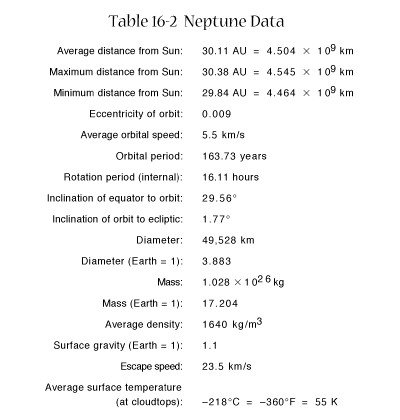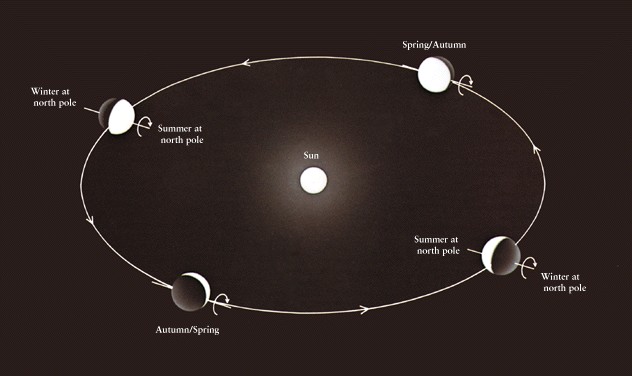Uranus
and Neptune
Printable
version
April
25, 2000
Announcements
Uranus
and Neptune Preview
-
Jupiter,
Saturn, Uranus, Neptune,
Pluto
-
Uranus
overview (Jovian planet)
-
Neptune
overview (Jovian planet)
-
Discovery
of Uranus
-
Discovery
of Neptune
-
Triumph
of Newtonian mechanics
-
Seeing
Uranus and Neptune from Earth
-
Uranus
form Voyager 2
-
Featurless
upper atmosphere
-
weird
rotation axis tilt
-
composition
-
Neptune
from Voyager 2
-
More
active upper atmosphere
-
more
normal rotation axis tilt
-
Uranus
and Neptune possible internal structure
-
Unsolved
puzzles
Uranus
overview
-
Jupiter,
Saturn, Uranus, Neptune,
Pluto
-
5 AU,
10 AU, 20 AU, 30
AU, 40 AU
-
Differential rotation
-
inside slower than outside
-
poles slower than equator
-
Orbital period ~ one lifetime

-
Jupiter,
Saturn, Uranus, Neptune,
Pluto
-
5 AU,
10 AU, 20 AU, 30
AU, 40 AU
-
Differential rotation
-
What 4 other Solar system
bodies exhibit differential rotation?
-
Uranus,
Saturn, Jupiter, Sun
-
Orbital period ~ two lifetimes
-
Same size as Uranus, but
heavier
-
Uranus: 14.5 Earth Masses
-
Neptune: 17.2 Earth Masses
-
Which planet is denser?

Discovery
of Uranus
-
Jupiter,
Saturn, Uranus,
Neptune, Pluto
-
William
Herschel, 1781 doing a sky survey
-
noticed
something fuzzy
-
initially
thought a comet
-
moved
like a planet in a large orbit
-
phrase
of scientific discovery is usually not "Eureka" but "Hmm, that's funny"
-
Uranus
had been charted as a star as early as 1690
-
moves
4 degrees every year
Discovery
of Neptune
-
Jupiter,
Saturn, Uranus, Neptune,
Pluto
-
Uranus
wasn't moving as expected
-
1843
John Couch Adams used discrepancy to predict position of undiscovered planet
(Neptune)
-
1845
Le Verrier made same calculation
-
predicted
position within 1 degree of Adams'
-
English
observers hesitant to look for planet because didn't have a good map of
that part of the sky
-
Le
Verrier gave predicted position to Berlin observatory
-
Had
good maps
-
found
Neptune in one night
-
In
1613, Galileo probably saw it while observing Jupiter
-
didn't
pay much attention to it
-
Jupiter
moved past Neptune, Neptune was "lost" for 200 years
-
Neptune
moves only 2 degrees per year
Seeing
Uranus and Neptune from Earth
-
Not naked eye objects
-
Need a good, big telescope
Uranus
from Voyager 2
-
Jupiter,
Saturn, Uranus,
Neptune, Pluto
-
Uranus
upper atmosphere almost featureless even from Voyager
-
Rotation
axis tilted nearly into plain of orbit around Sun!
-
98
degree tilt
-
net
rotation is retrograde (backwards)
-
probably
rotating normally, then hit by something
-
what
other planet (that we've learned about so far) has retrograde rotation
-
LONG
seasons (~20 years)
-
84%
hydrogen, 14% helium, 2% methane
-
methane
absorbs reds and yellows
-
why
Uranus is greenish blue
-
Unlike
Jupiter and Saturn, there is no ammonia (NH3) in Uranus's upper
atmosphere
-
Uranus
upper atmosphere temperature is 55K
-
ammonia
is frozen, rains down to bottom of atmosphere
-
probably
why no water either
-
A similar
mechanism may have depleted Helium in the outer atmosphere of what planet?
-
ammonia
and water are important constituents of the clouds of what planets?
-
Upper
atmosphere winds move west to east (like rotation)
-
No
zonal winds like Jupiter or Saturn
-
Temperatures
in winter similar at poles and equator (at top of atmosphere)
-
must
have good circulation


Neptune
from Voyager 2
-
Jupiter,
Saturn, Uranus, Neptune,
Pluto
-
Neptune
more dense
-
Has
internal heat source
-
may
still be contracting from formation
-
upper
atmosphere temperature 55 K
-
30
degree tilt of rotational axis
-
84%
hydrogen, 14% helium, 2% methane (same as Uranus)
-
No
water, no ammonia
-
what
color is Neptune?
-
Has
clouds, storms
-
clouds
may be frozen methane
-
great
dark spot in southern hemisphere
-
there
in 1989, gone in 1994
-
new
storm in northern hemisphere in 1995\
-
Has
some belts and zones
Neptune,
cloud close up


Belts
and Zones in Neptune (data from Larry Sromovsky of UW)

Internal
structure
-
Jupiter,
Saturn, Uranus, Neptune,
Pluto
-
Internal
structure not precisely known
-
rocky
core almost certain
-
outer
atmosphere known
-
the
rest is calculated
-
how
do we know about the internal structure of the Earth?
-
Seismic
waves (Earthquakes)
-
Magnetic
fields of Uranus and Neptune not centered nicely
-
tilted
at large angles relative to rotation axis
-
moving
electric charges cause magnetic fields
-
charges
exist in:
-
Earth:
liquid iron
-
Jupiter
and Saturn: liquid metallic hydrogen
-
Uranus
and Neptune: ions in water?


Unsolved
Puzzles
-
Jupiter,
Saturn, Uranus, Neptune,
Pluto
-
Why
is Uranus tilted so much?
-
Why
are there more heavy elements in Uranus and Neptune
-
What
causes their misaligned magnetic fields?
-
What
is Neptune's heat source?
-
One
possible cause for all of these:
-
Uranus
and Neptune formed closer to the sun and were thrown out by large impacts
Uranus
and Neptune Summary
-
Jupiter,
Saturn, Uranus, Neptune,
Pluto
-
Uranus
overview (Jovian planet)
-
Neptune
overview (Jovian planet)
-
Discovery
of Uranus
-
Discovery
of Neptune
-
Triumph
of Newtonian mechanics
-
Seeing
Uranus and Neptune from Earth
-
Uranus
form Voyager 2
-
Featureless
upper atmosphere
-
weird
rotation axis tilt
-
composition
-
Neptune
from Voyager 2
-
More
active upper atmosphere
-
more
normal rotation axis tilt
-
Uranus
and Neptune possible internal structure
-
Unsolved
puzzles









